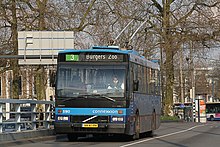
A bus is a road vehicle that carries significantly more passengers than an average car or van, but less than the average rail transport. It is most commonly used in public transport, but is also in use for charter purposes, or through private ownership. Although the average bus carries between 30 and 100 passengers, some buses have a capacity of up to 300 passengers. The most common type is the single-deck rigid bus, with double-decker and articulated buses carrying larger loads, and midibuses and minibuses carrying smaller loads. Coaches are used for longer-distance services. Many types of buses, such as city transit buses and inter-city coaches, charge a fare. Other types, such as elementary or secondary school buses or shuttle buses within a post-secondary education campus, are free. In many jurisdictions, bus drivers require a special large vehicle licence above and beyond a regular driving licence.

Traffic lights, traffic signals, or stoplights – also known as robots in South Africa and Namibia – are signalling devices positioned at road intersections, pedestrian crossings, and other locations in order to control the flow of traffic.

A bus stop is a place where buses stop for passengers to get on and off the bus. The construction of bus stops tends to reflect the level of usage, where stops at busy locations may have shelters, seating, and possibly electronic passenger information systems; less busy stops may use a simple pole and flag to mark the location. Bus stops are, in some locations, clustered together into transport hubs allowing interchange between routes from nearby stops and with other public transport modes to maximise convenience.

A variable-message sign or message board, often abbreviated VMS, VMB, CMS, or DMS, and in the UK known as a matrix sign, is an electronic traffic sign often used on roadways to give travelers information about special events. Such signs warn of traffic congestion, accidents, incidents such as terrorist attacks, AMBER/Silver/Blue Alerts, roadwork zones, or speed limits on a specific highway segment. In urban areas, VMS are used within parking guidance and information systems to guide drivers to available car parking spaces. They may also ask vehicles to take alternative routes, limit travel speed, warn of duration and location of the incidents, inform of the traffic conditions, or display general public safety messages.

An articulated bus, also referred to as a slinky bus, bendy bus, tandem bus, vestibule bus, stretch bus, or an accordion bus, is an articulated vehicle, typically a motor bus or trolleybus, used in public transportation. It is usually a single-decker, and comprises two or more rigid sections linked by a pivoting joint (articulation) enclosed by protective bellows inside and outside and a cover plate on the floor. This allows a longer legal length than rigid-bodied buses, and hence a higher passenger capacity (94–120), while still allowing the bus to maneuver adequately.

New York City Subway nomenclature is the terminology used in the New York City Subway system as derived from railroading practice, historical origins of the system, and engineering, publicity, and legal usage. Important terms include lines, or individual sections of subway, like the BMT Brighton Line; services, like the B, which is a single train route along several lines; and stations, such as Coney Island–Stillwell Avenue, which connects multiple lines and services.
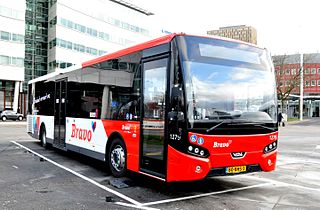
A transit bus is a type of bus used in public transport bus services. Several configurations are used, including low-floor buses, high-floor buses, double-decker buses, articulated buses and midibuses.
The Massachusetts Bay Transportation Authority (MBTA) maintains a large public transit system in the Boston, Massachusetts area, and uses various methods to name and number their services for the convenience of users.

The flip-disc display is an electromechanical dot matrix display technology used for large outdoor signs, normally those that will be exposed to direct sunlight. Flip-disc technology has been used for destination signs in buses across North America, Europe and Australia, as well as for variable-message signs on highways. It has also been used extensively on public information displays. A few game shows have also used flip-disc displays, including Canadian shows like Just Like Mom, The Joke's on Us and Uh Oh!, but most notably the American game show Family Feud from 1976 to 1995 and its British version Family Fortunes from 1980 to 2002. The Polish version of Family Feud, Familiada, still uses this board, which was bought from the Swedish version of the show. In 2012, Brooklyn-based artist studio, BREAKFAST, began engineering a modernized Flip-Disc technology which was eventually able to flip the discs at over 40 times per second.
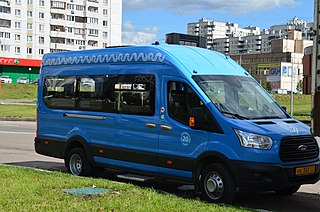
Marshrutnoye taksi, commonly known by the colloquialism Marshrutka, are share taxis found in Eastern Europe and the republics of the former Soviet Union. Usually vans, they drive along set routes, depart only when all seats are filled, and may have higher fares than buses. Passengers can board a marshrutka anywhere along its route if there are seats available.

In public transport, a request stop, flag stop, or whistle stop is a stop or station at which buses or trains, respectively, stop only on request; that is, only if there are passengers or freight to be picked up or dropped off. In this way, stops with low passenger counts can be incorporated into a route without introducing unnecessary delay. Vehicles may also save fuel by continuing through a station when there is no need to stop.

A split-flap display, or sometimes simply a flap display, is a digital electromechanical display device that presents changeable alphanumeric text, and occasionally fixed graphics.

The Gillig Phantom is a series of buses that was produced by an American manufacturer Gillig Corporation in Hayward, California. The successor to the long-running Gillig Transit Coach model line, the Phantom marked the transition of Gillig from a producer of yellow school buses to that of transit buses. The first transit bus assembled entirely by Gillig, the Phantom was produced exclusively as a high-floor bus.
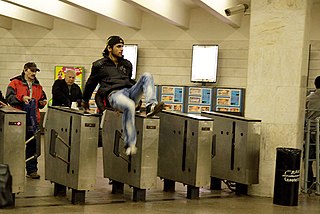
Fare evasion or fare dodging is the act of travelling on public transport without paying by deliberately not buying a required ticket to travel. It is considered a problem in many parts of the world, and revenue protection officers and ticket barriers, staffed or automatic, are in place to ensure only those with valid tickets may access the transport. The term fare avoidance is sometimes used as a euphemistic synonym and sometimes used to refer to the lawful use of much cheaper tickets.
In public transportation, schedule adherence or on-time performance refers to the level of success of the service remaining on the published schedule. On time performance, sometimes referred to as on time running, is normally expressed as a percentage, with a higher percentage meaning more vehicles are on time. The level of on time performance for many transport systems is a very important measure of the effectiveness of the system.

Public transport bus services are generally based on regular operation of transit buses along a route calling at agreed bus stops according to a published public transport timetable.
A vehicle tracking system combines the use of automatic vehicle location in individual vehicles with software that collects these fleet data for a comprehensive picture of vehicle locations. Modern vehicle tracking systems commonly use GPS or GLONASS technology for locating the vehicle, but other types of automatic vehicle location technology can also be used. Vehicle information can be viewed on electronic maps via the Internet or specialized software. Urban public transit authorities are an increasingly common user of vehicle tracking systems, particularly in large cities.

Terminology related to road transport—the transport of passengers or goods on paved routes between places—is diverse, with variation between dialects of English. There may also be regional differences within a single country, and some terms differ based on the side of the road traffic drives on. This glossary is an alphabetical listing of road transport terms.
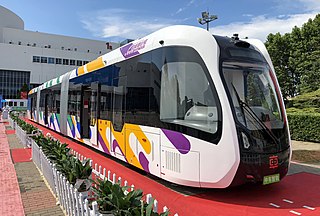
Autonomous Rail Rapid Transit (ART) is a lidar guided articulated bus system for urban passenger transport. Developed and manufactured by CRRC through CRRC Zhuzhou Institute Co Ltd, it was unveiled in Zhuzhou in the Hunan province on June 2, 2017. ART has been described as a combination between a bus and a tram. Its exterior is composed of individual fixed sections joined by articulated gangways, resembling a rubber-tyred tram.

The TriMet transit system, serving the Portland metropolitan area in Oregon, owns and operates two different rail transit systems: a light rail system known as MAX, and a commuter rail system known as WES. The fleet of 145 MAX electric light rail vehicles (LRVs) includes five different models, designated by TriMet as "Type 1" through "Type 6". All types are used on all of the MAX lines, but the Type 6 cars – which will gradually replace the Type 1 cars – are still being delivered and have not yet begun to enter service. The comparatively very small WES fleet includes three different types of diesel commuter rail cars.

